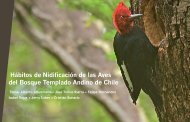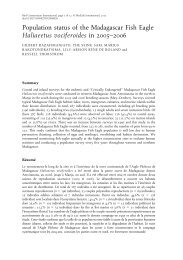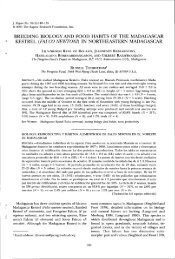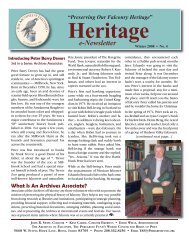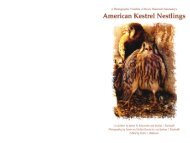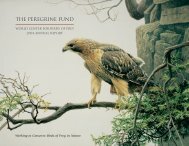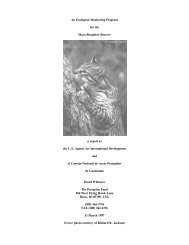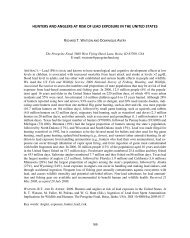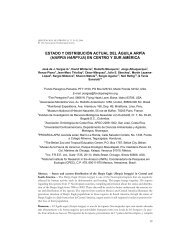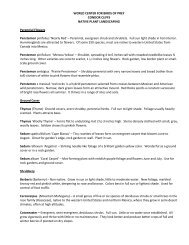Lake Baringo - Another casualty of the furadan scourge
Lake Baringo - Another casualty of the furadan scourge
Lake Baringo - Another casualty of the furadan scourge
You also want an ePaper? Increase the reach of your titles
YUMPU automatically turns print PDFs into web optimized ePapers that Google loves.
SPOTLIGHT<br />
<strong>Ano<strong>the</strong>r</strong> <strong>casualty</strong> <strong>of</strong><br />
<strong>the</strong> <strong>furadan</strong> <strong>scourge</strong><br />
We always want to know more. This trait is inherently<br />
human; we learn throughout our lives. Knowledge<br />
breeds curiosity, and curiosity takes us to wonderful<br />
places. With this in mind, I headed to <strong>Lake</strong> <strong>Baringo</strong>…<br />
THE AUTHOR<br />
SHIV KAPILA was born and raised in<br />
Kenya before pursuing studies in <strong>the</strong> United<br />
Kingdom. He received a Masters degree<br />
in Conservation from University College<br />
London and has been working on African<br />
Fish Eagles at <strong>Lake</strong> Naivasha and <strong>Baringo</strong><br />
with support from The Peregrine Fund and<br />
<strong>the</strong> National Museums <strong>of</strong> Kenya.<br />
After working on <strong>the</strong> African<br />
Fish Eagle, Haliaeetus<br />
vocifer, at <strong>Lake</strong> Naivasha for<br />
close to two years, my affinity<br />
for <strong>the</strong>se birds has almost developed<br />
into an obsession. They are a reliable<br />
and rewarding raptor to study, and<br />
supremely dignified and graceful. I was<br />
keen to expand my research on Fish<br />
Eagles to o<strong>the</strong>r areas, and with good<br />
cause. Although considered a relatively<br />
common bird throughout most <strong>of</strong> its<br />
range, as birds <strong>of</strong> prey go, <strong>the</strong> African<br />
Fish Eagle is an ideal candidate to use<br />
as an umbrella species, an indicator<br />
species <strong>of</strong> environmental change. As<br />
a slow-to-mature bird and an apex<br />
predator with low rates <strong>of</strong> reproduction,<br />
this raptor can accurately <strong>of</strong>fer early<br />
warning signals <strong>of</strong> environmental<br />
stress. Their population and breeding<br />
structures and observed fluctuations<br />
can also, and <strong>of</strong>ten do, reflect changes in<br />
conditions within <strong>the</strong>ir ecosystems. By<br />
studying <strong>the</strong>se fluctuations, <strong>the</strong>y enable<br />
scientists to assess <strong>the</strong> health <strong>of</strong> <strong>the</strong><br />
ecosystem, and, by protecting <strong>the</strong>m, we<br />
invariably conserve <strong>the</strong>ir entire habitat.<br />
The birds are most commonly found<br />
around freshwater lakes and rivers, and<br />
in Kenya this means <strong>Lake</strong>s Naivasha<br />
and <strong>Baringo</strong>.<br />
<strong>Lake</strong> <strong>Baringo</strong> is radically different<br />
from <strong>Lake</strong> Naivasha; at only 160<br />
km north <strong>of</strong> Naivasha, its altitude is<br />
over 1,000 metres lower. This has a<br />
dramatic effect on <strong>the</strong> temperature<br />
and vegetation. It’s warm enough to<br />
support crocodiles and dry enough to<br />
attract specialist bird species which<br />
one would only expect to encounter in<br />
58 SWARA JULY -SEPTEMBER 2012 www.eawildlife.org
Adult from Parmalok island fishing.<br />
www.eawildlife.org<br />
SWARA JULY -SEPTEMBER 2012 59
Female Fish Eagle catching its lunch.<br />
Being <strong>of</strong> similar size to <strong>Lake</strong> Naivasha, one<br />
would expect <strong>the</strong>re to be comparably similar<br />
populations <strong>of</strong> Fish Eagles, exhibiting <strong>the</strong><br />
same behavioural and breeding patterns.<br />
Unfortunately, numbers at <strong>Baringo</strong> have<br />
always been low.<br />
nor<strong>the</strong>rn Kenya’s arid scrublands - such<br />
characteristics mean <strong>the</strong> birds on <strong>the</strong><br />
local checklist approach 500 species.<br />
The differences do not end <strong>the</strong>re - <strong>the</strong><br />
shorelines are seemingly perfect for Fish<br />
Eagles: high cliffs directly overlooking<br />
<strong>the</strong> lake means <strong>the</strong> fishing should be<br />
easy, marshland abounds, providing<br />
cover and ample training grounds<br />
for juveniles, and maze-like island<br />
groups in <strong>the</strong> north seem to double <strong>the</strong><br />
available territory space.<br />
Being <strong>of</strong> similar size to <strong>Lake</strong><br />
Naivasha, one would expect <strong>the</strong>re to be<br />
comparably similar populations <strong>of</strong> Fish<br />
Eagles, exhibiting <strong>the</strong> same behavioural<br />
and breeding patterns. Unfortunately,<br />
numbers at <strong>Baringo</strong> have always<br />
been low. Fish Eagle counts were first<br />
conducted here in <strong>the</strong> late 1960s and<br />
early 1970s by <strong>the</strong> late Dr Leslie Brown,<br />
Kenya’s ”Fa<strong>the</strong>r <strong>of</strong> Raptor Biology”,<br />
whose highest recorded number was<br />
70 individuals including both adults<br />
and juveniles. The highest population<br />
at Naivasha was 224, recorded at <strong>the</strong><br />
same time as <strong>the</strong> 70 birds at <strong>Baringo</strong>.<br />
In those days, <strong>Baringo</strong> and its environs<br />
were almost pristine -development had<br />
hardly penetrated this far north and<br />
<strong>the</strong> lake’s conditions were assumed to<br />
exhibit a natural state, or as close to it<br />
as possible. A probable cause <strong>of</strong> <strong>the</strong>se<br />
low densities may be <strong>the</strong> lake’s location,<br />
climate and geography; <strong>Baringo</strong> is<br />
an oasis surrounded by desert, and<br />
its isolation may result in repelling<br />
wandering Fish Eagles, reluctant to<br />
even explore a habitat that may seem<br />
barren (a lone female on one <strong>of</strong> <strong>the</strong><br />
lake’s smaller islands who lost her<br />
mate in 2006 has not found ano<strong>the</strong>r<br />
after four years; at Naivasha she may<br />
have done so in less than a week). The<br />
resultant low turnover rates ensure that<br />
populations could be stable, but could<br />
rarely increase. Research continued in<br />
<strong>the</strong> late 1990s and early 2000s by Dr.<br />
Munir Virani (<strong>of</strong> The Peregrine Fund<br />
and <strong>the</strong> National Museums <strong>of</strong> Kenya)<br />
and by this time numbers had dropped<br />
to a low <strong>of</strong> 36 individuals, close to a 50%<br />
loss.<br />
60 SWARA JULY -SEPTEMBER 2012 www.eawildlife.org
SPOTLIGHT<br />
After a lull <strong>of</strong> five years, during which<br />
no counts were conducted, I made<br />
my first visit to <strong>Baringo</strong> in November<br />
2010. This was primarily to assist<br />
Masumi Gudka, a Kenyan student<br />
studying towards a Masters degree in<br />
Conservation Biology at <strong>the</strong> University<br />
<strong>of</strong> Cape Town. Gudka was looking at<br />
<strong>the</strong> chemistry and toxicology <strong>of</strong> <strong>Lake</strong><br />
Naivasha and how this is affected by<br />
large-scale horticulture. Intensive<br />
horticulture and agriculture is largely<br />
absent from <strong>the</strong> shores <strong>of</strong> <strong>Lake</strong> <strong>Baringo</strong>,<br />
so it was used as a control or neutral<br />
site to which we can compare <strong>Lake</strong><br />
Naivasha. Gudka was assessing levels<br />
<strong>of</strong> certain chemicals in lake sediment,<br />
water, fish and Fish Eagles. She had<br />
enlisted Simon Thomsett, Kenya’s<br />
leading authority on raptors, and myself<br />
to help trap <strong>the</strong> birds in order to draw<br />
some <strong>of</strong> <strong>the</strong>ir blood to test for particular<br />
toxins that <strong>the</strong>y may be exposed to.<br />
The numbers <strong>of</strong> Fish Eagles I<br />
counted was exceedingly low at only 20<br />
Adult turning in for a kill.<br />
individuals, including two juveniles and<br />
two transient (non-territorial) adults.<br />
This again, was close to a 50% loss from<br />
<strong>the</strong> previous count and represents a<br />
staggering rate <strong>of</strong> decline over those<br />
five years. The islands experienced <strong>the</strong><br />
most marked reduction; <strong>the</strong> largest <strong>of</strong><br />
<strong>the</strong>se islands (Ol Kokwe) lost four out<br />
<strong>of</strong> its five pairs. This highlighted <strong>the</strong><br />
gravest threat to this lake: poisoning.<br />
Despite bans on its distribution and<br />
sale, Furadan, a deadly carbamate is<br />
still sold, among o<strong>the</strong>rs, in larger towns<br />
close to <strong>Baringo</strong> such as Marigat, and<br />
is indiscriminately used in <strong>the</strong> area.<br />
Originally intended to combat nematode<br />
worms in <strong>the</strong> farming industry, this<br />
chemical has been abused; it has been<br />
used as a retaliatory killer to destroy<br />
problem carnivores, most infamously<br />
in <strong>the</strong> Maasai Mara Game Reserve with<br />
devastating effects. This lethal chemical<br />
is a major influence in causing a 60%<br />
decline in African vulture populations<br />
over <strong>the</strong> past two decades and severely<br />
depleting Kenya’s lion numbers. It<br />
and o<strong>the</strong>r poisons are used at <strong>Lake</strong><br />
<strong>Baringo</strong> for <strong>the</strong> same reason but with<br />
<strong>the</strong> desired effect <strong>of</strong> killing crocodiles.<br />
Crocodiles occasionally take goats and<br />
o<strong>the</strong>r livestock and <strong>the</strong> usual response is<br />
to kill <strong>the</strong>m by laying out poison-laced<br />
fish on <strong>the</strong> shore in areas where <strong>the</strong>y<br />
are known to frequent. This method<br />
is opportunistic and indiscriminate;<br />
<strong>of</strong>ten causing large-scale collateral<br />
damage: <strong>the</strong> most recent reported<br />
poisoning incident took place on Ol<br />
Kokwe in 2006 and not only killed eight<br />
crocodiles, but also thirteen Fish Eagles,<br />
www.eawildlife.org<br />
SWARA JULY -SEPTEMBER 2012 61
SPOTLIGHT<br />
Adult Fish Eagle showing leucistic wing patches.<br />
two Goliath Herons and two Monitor<br />
Lizards. Among <strong>the</strong> dead were two<br />
goats, <strong>the</strong> very animals <strong>the</strong> perpetrators<br />
were trying to protect.<br />
Normally top predator densities<br />
should recover, give enough time free<br />
from such disturbance, but o<strong>the</strong>r threats<br />
at <strong>Baringo</strong> hinder <strong>the</strong>ir increase: <strong>the</strong><br />
area has been speedily and steadily<br />
overrun an invasive plant. Mexican<br />
Mesquite, Prosopis juliflora 1 , was<br />
intentionally introduced to <strong>the</strong> <strong>Baringo</strong><br />
area in <strong>the</strong> 1980s to increase resources<br />
<strong>of</strong> fuel-wood. It quickly became clear<br />
that no matter how high <strong>the</strong> demand for<br />
its fuel <strong>the</strong> plant would spread quickly,<br />
and it now covers very large tracts <strong>of</strong><br />
land near <strong>the</strong> lake. Native Acacia trees<br />
and grasses have been out-competed<br />
and are virtually absent from <strong>the</strong> area.<br />
The effect is detrimental to both <strong>the</strong><br />
local human population who depend on<br />
<strong>the</strong> vegetation for <strong>the</strong>ir livestock and for<br />
<strong>the</strong> Fish Eagles that prefer to nest in <strong>the</strong><br />
tall Acacia trees that used to surround<br />
<strong>the</strong> lake’s shores. The situation has<br />
become so dire that <strong>the</strong> only active Fish<br />
Eagle nest we located was situated at<br />
<strong>the</strong> top <strong>of</strong> an invasive Kapok tree.<br />
After four years, <strong>the</strong> lake’s Fish Eagle<br />
numbers have declined precipitously<br />
to a low <strong>of</strong> 20 individuals, and this<br />
may be having an ominous effect on<br />
<strong>the</strong>ir health. Of <strong>the</strong> nine Fish Eagles<br />
that we trapped and banded in <strong>the</strong> last<br />
year or so, eight showed physiological<br />
characteristics <strong>of</strong> a severely stressed<br />
population. The physical mutations<br />
we found in <strong>the</strong>se Fish Eagles, such as<br />
hyperkeratinosis (abnormalities <strong>of</strong> <strong>the</strong><br />
scales on <strong>the</strong>ir feet that are made from<br />
keratin, just like our fingernails) and<br />
leucism (patches <strong>of</strong> plumage lacking<br />
any pigmentation), can be caused by<br />
numerous deficiencies and toxins,<br />
but also points to some degree <strong>of</strong><br />
inbreeding 2 . This could be as a result<br />
<strong>of</strong> a combination <strong>of</strong> low populations<br />
1<br />
This shrub is listed as one <strong>of</strong> <strong>the</strong> 100 most virulent invasive species and has been deliberately introduced to large areas <strong>of</strong> nor<strong>the</strong>rn Kenya.<br />
Reference: World’s Worst Invasive Alien Species: A selection from <strong>the</strong> Global Invasive Species Database. S. Lowe, M. Browne, S. Boudjelas, M. De Poorter. (2000) Published by The Invasive<br />
Species Specialist Group (ISSG), a specialist group <strong>of</strong> <strong>the</strong> Species Survival Commission (SSC) <strong>of</strong> <strong>the</strong> World Conservation Union (IUCN).<br />
2<br />
Leucism is only naturally present at a rate <strong>of</strong> 0.1%-1% in wild bird populations. Incidences where it manifests in a higher proportion <strong>of</strong> a population is most likely to be due to some degree <strong>of</strong><br />
inbreeding as it is an inherited condition.<br />
Reference:A case <strong>of</strong> leucism in <strong>the</strong> burrowing owl A<strong>the</strong>ne cunicularia (Aves: Strigiformes) with confirmation <strong>of</strong> species identity using cytogenetic analysis D. M. Nogueira, M. A. S. Alves.<br />
Zoologia (Curitiba, Impr.) vol.28 no.1<br />
62 SWARA JULY -SEPTEMBER 2012 www.eawildlife.org
SPOTLIGHT<br />
MAIN PHOTO: Adult soaring over <strong>the</strong> lake.<br />
INSERT: Releasing a newly tagged adult<br />
on <strong>the</strong> North side <strong>of</strong> <strong>the</strong> lake.<br />
with a minimal turnover rate: very few<br />
wandering adults get to <strong>the</strong> lake and<br />
those that are resident breed at very<br />
slow rates, so <strong>the</strong> gene pool remains<br />
small. Accounting for <strong>the</strong>se factors, <strong>the</strong><br />
lake may cease to support any <strong>of</strong> <strong>the</strong>se<br />
powerful and captivating raptors in<br />
as little as ten years. The Fish Eagles<br />
at <strong>Baringo</strong> have been calculated to<br />
collectively generate over USD 150,000<br />
per annum for <strong>the</strong> area in terms <strong>of</strong><br />
tourism revenue and expenditure.<br />
Thus <strong>the</strong> loss <strong>of</strong> even one <strong>of</strong> <strong>the</strong>se birds<br />
to retaliatory poisoning significantly<br />
impacts <strong>the</strong> local community.<br />
<strong>Lake</strong> <strong>Baringo</strong> was declared a<br />
Ramsar site, a wetland <strong>of</strong> international<br />
importance, in 2002 but so far it has<br />
not been treated as such. Solutions<br />
to <strong>the</strong>se problems are long term, but<br />
worth considering. Campaigns against<br />
<strong>the</strong> spread <strong>of</strong> <strong>the</strong> Mexican Mesquite<br />
can involve <strong>the</strong> continued use for fuel<br />
and with <strong>the</strong> addition <strong>of</strong> using its wood<br />
for furniture and construction, and its<br />
pods for livestock feed and flour. This<br />
has been done successfully in South<br />
America, India and Niger where <strong>the</strong><br />
plant has also invaded and taken a<br />
stranglehold <strong>of</strong> <strong>the</strong> landscape, but in<br />
<strong>the</strong>se countries, people have learned to<br />
look upon <strong>the</strong> plant as a resource and<br />
have successfully arrested its increase.<br />
The response to poisoning could<br />
be more immediate in <strong>the</strong> form <strong>of</strong> a<br />
total countrywide ban, but without<br />
punishment abuse could still, and <strong>of</strong>ten<br />
does, continue in more remote areas.<br />
Education against its effects from a<br />
young age can have more permanent<br />
impacts over <strong>the</strong> long run, and some<br />
success is being seen with education<br />
programmes held in conjunction with<br />
<strong>the</strong> International Vulture Awareness<br />
Day scheme.<br />
These strategies, although dependent<br />
on a huge change in attitudes and<br />
practices, can work with careful<br />
implementation. <strong>Lake</strong> Naivasha has<br />
already suffered <strong>the</strong> indignity <strong>of</strong><br />
being downgraded to <strong>the</strong> Montreux<br />
Record <strong>of</strong> degraded wetlands due to<br />
<strong>the</strong> unsustainable fashion in which it<br />
has been exploited by industry. <strong>Lake</strong><br />
<strong>Baringo</strong> can and should avoid this<br />
embarrassment with some warranted<br />
and necessary effort.<br />
As I sit on <strong>the</strong> shores <strong>of</strong> <strong>the</strong> lake at<br />
Robert’s Camp, gazing at <strong>the</strong> sun setting<br />
over <strong>the</strong> horizon, lighting up <strong>the</strong> lake’s<br />
surface with a shimmering glow, I can’t<br />
help wondering what <strong>Baringo</strong> would be<br />
like without its charismatic hunters: its<br />
crocodiles and its Fish Eagles. Would<br />
it produce such amazement, encourage<br />
such inspiration? Or would it become<br />
just ano<strong>the</strong>r ‘muddy puddle’, resigned<br />
to this fate because <strong>of</strong> neglect and<br />
mismanagement?<br />
www.eawildlife.org<br />
SWARA JULY -SEPTEMBER 2012 63



